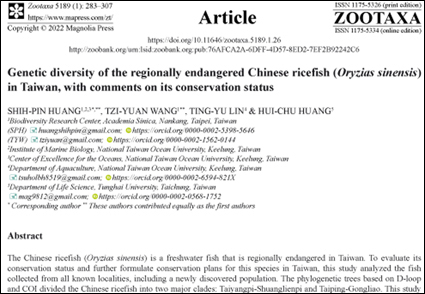Abstract
The Chinese ricefish (Oryzias sinensis) is a freshwater fish that is regionally endangered in Taiwan. To evaluate its conservation status and further formulate conservation plans for this species in Taiwan, this study analyzed the fish collected from all known localities, including a newly discovered population. The phylogenetic trees based on D-loop and COI divided the Chinese ricefish into two major clades: Taiyangpi-Shuanglienpi and Taiping-Gongliao. This study showed that both the Shuanglienpi and Taiyangpi wild populations had significantly higher Hd and π values, while the Shuanglienpi restored population only had one haplotype from the wild. However, their genetic diversity may have decreased over the past few decades. The Gongliao and Taiping populations shared the same haplotype as a population from a previous study. We propose that the Gongliao and Taiping populations were founded by a few individuals and might have originated from a single introduction event from southeastern mainland China. Low genetic diversity was clearly observed in the Taiping, Gongliao and Shuanglienpi restored populations. Based on the present investigation and previous studies, the invasive poeciliid fish (such as mosquitofish and green swordtail) contribute the most to the decline of the Chinese ricefish population and genetic diversity in Taiwan.
References
Chen, H.-J. (2009) The habitat, population investigation and ecology of Taiwan native ricefish. Department of Science Education, National Taipei University of Education, Master thesis, Taipei, 61 pp. [in Chinese]
Chen, I.-S. & Fang, L.-S. (1999) The freshwater and estuarine fishes of Taiwan. The Preparatory Office of National Museum of Marine Biology & Aquarium Press, Pingtung, 287 pp. [in Chinese]
Chen, I.-S., Huang, S.-P. & Liu, C.-C. (2010) Alien, invasive freshwater fishes in Taiwan. National Taiwan Ocean University Press, Keelung, 127 pp. [in Chinese]
Chen, I.-S., Tzeng, C.-S. & Shao, K.-T. (2011) Survey and conservation strategy of the freshwater fish resources of rivers, lakes and ponds of Taiwan. Forestry Bureau Press, Taipei, 539 pp. [in Chinese]
Chen, I.-S., Tzeng, C.-S. & Shao, K.-T. (2012) Red data book of freshwater fishes in Taiwan. Forestry Bureau Press, Taipei, 242 pp. [in Chinese]
Excoffier, L. & Lischer, H.E.L. (2010) Arlequin ver. 3.5: A new series of programs to perform population genetics analyses under Linux and Windows. Molecular Ecology Resources, 10, 564‒567. https://doi.org/10.1111/j.1755-0998.2010.02847.x
Hall, T.A. (2001) Bioedit: a user-friendly biological sequence alignment editor and analysis, version 5.09. Raleigh, North Carolina: Department of Microbiology, North Carolina State University, Raleigh.
Hirayama, M., Mukai, T., Miya, M., Murata, Y., Sekiya, Y., Yamashita, T., Nishida, M., Watabe, S., Oda, S. & Mitani, H. (2010) Intraspecific variation in the mitochondrial genome among local populations of Medaka Oryzias latipes. Gene, 457, 13–24. https://doi.org/10.1016/j.gene.2010.02.012
Holt, W.V., Bennett, P.M. & Volobouev, V. (1996) Genetic resource banks in wildlife conservation. Journal of Zoology of London, 238, 531–544. https://doi.org/10.1111/j.1469-7998.1996.tb05411.x
In, D.-S., Choi, E.-S., Yoon, J.-D., Kim, J.-H., Min, J.-I., Baek, S.-H. & Jang, M.-H. (2013) Cytochrome oxidase subunit I (COI) DNA sequence divergence between two cryptic species of Oryzias in South Korea. Journal of Ecology and Environment, 36 (3), 159–166. https://doi.org/10.5141/ecoenv.2013.159
Kano, Y., Tabata, R., Nakajima, J., Takada-Endo, M., Zhang, C., Zhao, Y., Yamashita, T. & Watanabe, K. (2018) Genetic characteristics and possible introduced origin of the paradise fish Macropodus opercularis in the Ryukyu Archipelago, Japan. Ichthyological Research, 65, 134–141. https://doi.org/10.1007/s10228-017-0602-7
Kumar, S., Stecher, G. & Tamura, K. (2016) MEGA7: Molecular Evolutionary Genetics Analysis version 7.0 for bigger datasets. Molecular Biology and Evolution, 33, 1870–1874. https://doi.org/10.1093/molbev/msw054
Ma, J.-G., Long, S.-S. & Wang, Z.-D. (2019) Complete mitogenome and phylogenetic analysis of Oryzias celebensis (Teleostei: Beloniformes). Mitochondrial DNA Part B, Resources, 5 (1), 27–28. https://doi.org/10.1080/23802359.2019.1695550
Parenti, L.R. (2008) A phylogenetic analysis and taxonomic revision of ricefishes, Oryzias and relatives (Beloniformes, Adrianichthyidae). Zoological Journal of the Linnean Society, 154, 494–610. https://doi.org/10.1111/j.1096-3642.2008.00417.x
Rozas, J., Sánchez-DelBarrio, J.C., Messeguer, X. & Rozas, R. (2003) DnaSP, DNA polymorphism analyses by the coalescent and other methods. Bioinformatics, 19, 2496–2497. https://doi.org/10.1093/bioinformatics/btg359
Sato, H., Okubo, S., Sasa, M., Wada, Y., Motoki, M., Tanaka, H., Yamagishi, H., Okino, T. & Kurihara, T. (1972) Observations on Gambussia affinis introduced into Tokushima as a natural enemy of mosquitoes. Japan Society of Medical Entomology and Zoology in Medical Entomology and Zoology, 23, 113–127. [in Japanese] https://doi.org/10.7601/mez.23.113
Setiamarga, D.H., Miya, M., Yamanoue, Y., Mabuchi, K., Satoh, T.P., Inoue, J.G. & Nishida, M. (2008) Interrelationships of Atherinomorpha (medakas, flyingfishes, killifishes, silversides, and their relatives): The first evidence based on whole mitogenome sequences. Molecular Phylogenetics and Evolution, 49 (2), 598–605. https://doi.org/10.1016/j.ympev.2008.08.008
Shao, K.-T. (2022) The Fish Datebase of Taiwan. Available from: http://fishdb.sinica.edu.tw (accessed 29 June 2022)
Shih, H.-T., Shy, J.-Y., Naruse, T., Hung, H.-T., Yeo, D.C.J. & Ng, P.K.L. (2011) Introduction of an indochinese freshwater crab Sayamia germaini (Crustacea: Brachyura: Gecarcinucidae) to Taiwan: Morphological and molecular evidence. Raffles Bulletin of Zoology, 59 (1), 83–90.
Tzeng, C.-S., Lin, Y.-S., Lin, S.-M., Wang, T.-Y. & Wang, F.-Y. (2006) The phylogeography and population demographics of selected freshwater fishes in Taiwan. Zoological Studies, 45, 285–297.
Wang, J. Cong, V.-H. & Sakakibara, Y. (2014) Competition between medaka (Oryzias latipes) and mosquitofish (Gambusia affinis) under different temperatures. Conference: Proceedings from the 7th International Conference on Environmental Science and Technology, Texas, USA, Vol 2.
Wang, Z.-D., Long, S.-S., Liao, J., Huang, C.-Q., Zhang, H.-R., Huang, S.-K., Zhang, Y.-P., Liu, L. & Guo Y.-S. (2017) Complete mitogenome of Hainan medaka Oryzias curvinotus (Teleostei: Beloniformes) and transcriptional differences between male and female liver. Mitochondrial DNA Part B, Resources, 2 (1), 157–158. https://doi.org/10.1080/23802359.2017.1303340
Ward, R.D., Zemlak, T.S., Innes, B.H., Last, P.R. & Hebert, P.D.N. (2005) DNA barcoding Australia’s fish species. Philosophical Transactions of the Royal Society B-Biological Sciences, 360, 1847–1857. https://doi.org/10.1098/rstb.2005.1716
Yang, C.-H., Tseng, T.-J., Lin, R.-S., Tzeng, C.-S. & Liao, T.-Y. (2017) The red list of freshwater fishes of Taiwan. Endemic Species Research Institute Press, Nantou. 47 pp. [in Chinese]


